‘Behemoth’ is a word which springs to mind or, perhaps more nautically, ‘leviathan’.
- Stability at rest
- Fast, smooth ride thanks to dihedral hydrofoil assitance and assymetric hulls.
- Spacious interior, huge cockpit and foredeck
- Good looking boat
Family Boats introduces the Lazercat 950, the first twin-hulled design from aluminium trailerboat manufacturer Lazercraft. This powercat is such a departure from Lazercraft’s previous models it gets a whole new name: Lazercat.
Lazercraft’s been producing aluminium runabouts from its factory in Dunedin since 1984, and although one of the smaller manufacturers in terms of volume, it’s built a solid reputation for smooth-riding monohull designs in the mid-sized runabout market.

So, when the company decided to develop a somewhat larger power catamaran, it was time for a new name and a new game. Lazercats was born, and the Lazercat 950 is the first twin-hull offering, available from Family Boats in Auckland.
With an outboard-powered catamaran configuration based on asymmetrical hulls and a dihedral hydrofoil below the waterline, Lazercat aims to continue the reputation for a smooth-riding hull while adding the considerable benefits of a catamaran configuration.
At the same time, it has retained the merging of aluminium hulls with other materials to give the best of both worlds – the strength and rigidity of an alloy hull with the warmth and sound absorption of composite and plastic cabinetry and finishings.
Key to this solution is the very latest technology in hull and foil design. The asymmetric hulls provide the same ride benefits as a monohull – efficiently cutting through any chop or waves without the pounding that some flat-bottom cats exhibit at speed.
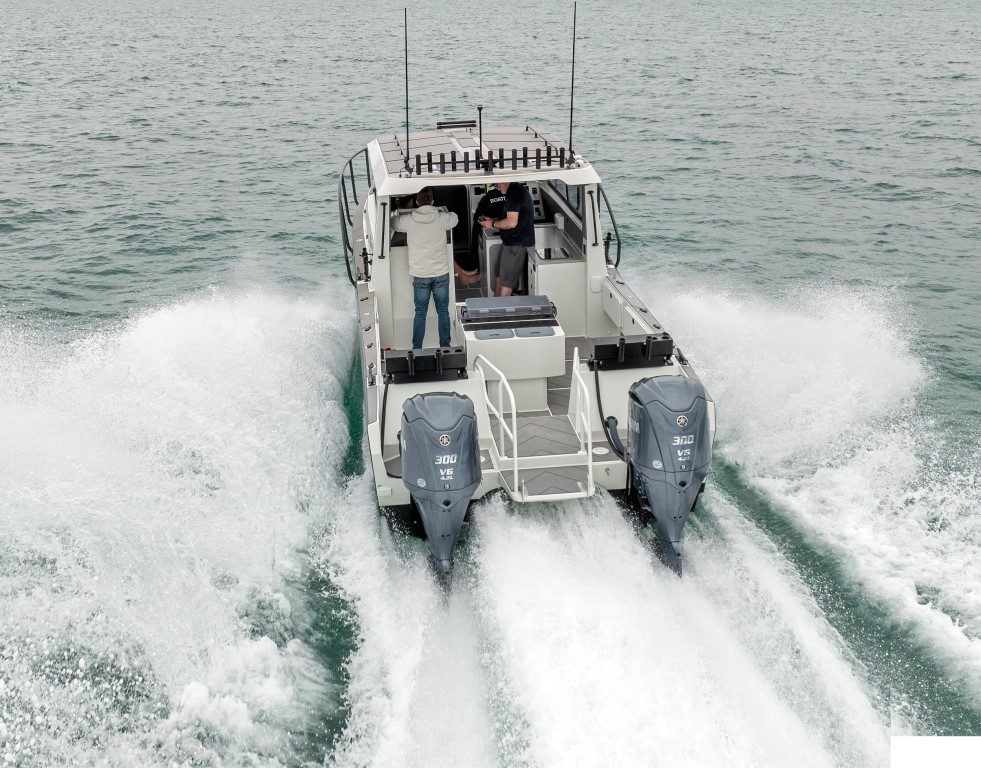
Turning is also a pleasure, with the inner surface of each hull providing a keel-like action to enable positive and tight turns with very little sideslip. It also heels slightly into the turn the way a monohull does, reducing the sideways force that can affect passengers on some cats.
The dihedral foil is another important component. Lazercraft general manager Jeremy Behrens says the design is based on more than 20 years of experience working on hydrofoil-supported catamarans.
The Lazercat’s foil was developed by himself in collaboration with Dr Gunther Migeotte of Icarus Marine Naval architects. The dihedral shape of the foil not only provides lift to reduce the wetted surface (and hence reduce drag) but also continues to provide that lift even when the boat turns sharply.
The net result is a boat that has an astonishing top speed without using significantly more fuel and the ability to maintain that top speed through rough water or while turning.
So it was with some excitement that we boarded Zambezi, the first Lazercat 950 from the factory. Finished off in a stylish deep metallic blue with bright white cabin sides, this vessel’s equipped as a day boat suited for offshore game fishing.
As such, it has a massive berth in the forward cabin, as well as a modest galley and the all-important flush toilet. However, it is not really set up for overnighting – the open-backed cabin and limited storage are best-suited to a fast trip to the fishing grounds and a comfortable day’s fishing.
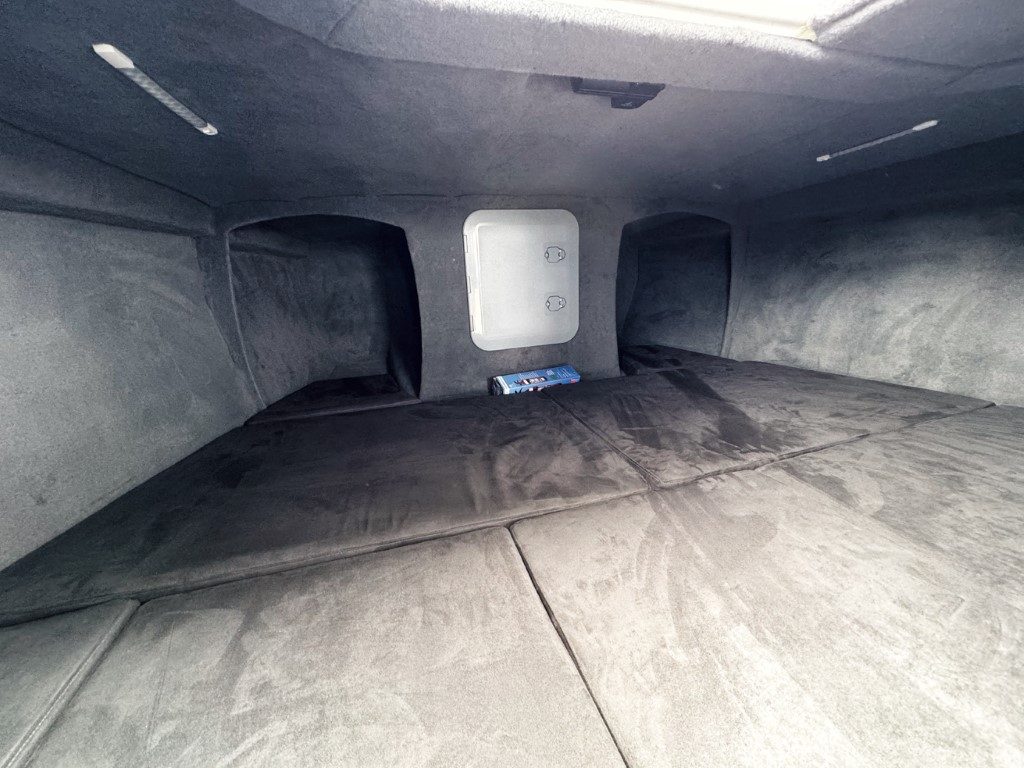
Zambezi’s dominated by the twin Yamaha F300 outboards hanging off the back. These are counter-rotating and have Yamaha digital electric steering actuators. This enables them to be controlled by the Helm Master EX system, allowing them to be independently steered and enabling the boat to move sideways (using a joystick control) without a bow thruster.
These also take up less space than conventional hydraulic steering rams, leaving a very generous standing area behind each motor. The engines also are mounted on Seastar hydraulic jacking plates, enabling their height to be optimised to suit the load and conditions.
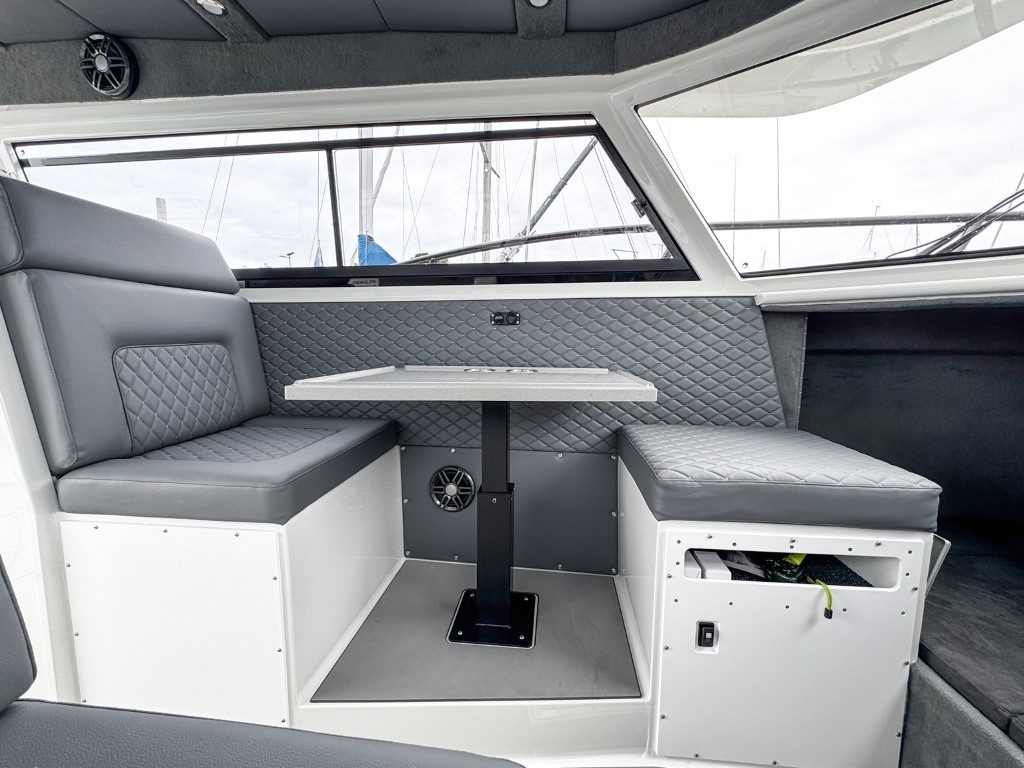
In addition, a wide walkway between the motors allows for easy boarding from a marina berth as well as being a fantastic fishing platform. All deck surfaces are covered with grey U-Dek foam, making them smart, comfortable and non-slip – even when wet.
Thanks to the 3.1m beam the main cockpit is huge. A fishing station has been installed in the middle of the cockpit, containing a pair of live bait tanks and a large chilly bin. Bait boards or filleting stations are located either side of the transom, powder-coated in black and each with a couple of rod holders and a tackle drawer.
Hatches in each gunwale provide additional storage space for fishing gear. The front of the station contains a padded double seat for fishing mates to sit on while underway.
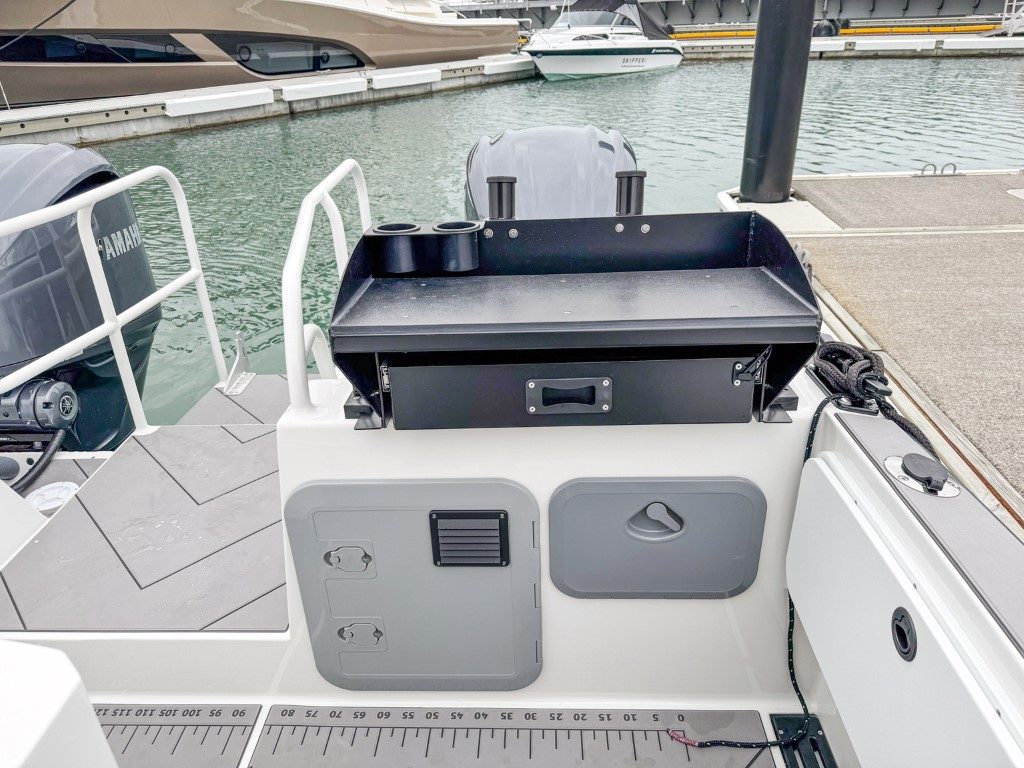
This boat’s an out-and-out fishing machine, as evidenced by no fewer than 25 rod holders in total: a double-row rocket launcher along the rear lip of the hardtop, four rod holders set into either gunwale and four on the transom. There are also two Oceanblue outrigger mounts either side of the hardtop. The only thing missing is a game chair, although there is plenty of space to fit one if required.
The main cabin features a galley on the starboard side – with the dining table and seats and the toilet compartment to port. The galley’s equipped with a fridge and a two-burner hob, plus storage drawers.
The fully-enclosed toilet is ¾ height, enabling comfortable entry. All upholstery is a smart grey with diamond-pattern stitching, and cupboard doors are all solid CNC-cut plastic.
The helm station is well-equipped and simple to operate, thanks to the simplified switching that’s been implemented. The Black Box GME VHF means that all functions are accessible from the handset, and a Fusion stereo provides your choice of music.

The main display is a Garmin 8416 XSV with a 1kW transducer and a 600W 3D transducer, which provides chart plotter, 3D fish finder and autopilot functions. The Yamaha Helm Master is controlled by the CL5 touch screen as well as the joystick and autopilot controls. Switches for the Maxwell Tasman 8 anchor winch, and of course, the digital throttle and shift controls for the twin motors, complete the helm.
Forward is the cabin with an expansive double berth thanks to the width provided by the twin hulls. A hatch provides fresh air and (optionally) also access to the foredeck from within the cabin.
The black-painted railing around the side of the cabin and the bow are cleverly fastened to the outside of the hull, ensuring there’s nothing on the deck to stub your toes. The entire hull is painted (no bare aluminium visible anywhere) and is smart and well-finished.
But it is not just good looks – with the 12mm aluminium transom, 10mm keel and 5mm hull this is a robust vessel that will handle a lot of abuse.

The Ride
With a light-ship weight of 3.8 tonnes and 600hp on tap, she was always going to be fast. Even running the engines just over half throttle on 3,100rpm, we were already doing close to 20 knots while using just 50 litres per hour (2.5 litres per nautical mile).
Pushing her to 5000rpm, we soon had 37 knots on the clock and still consuming a very reasonable 3.6 litres per nautical mile. This gives the 550-litre fuel tank a range in excess of 200 nautical miles, and there is an optional 800-litre tank to extend this even further.
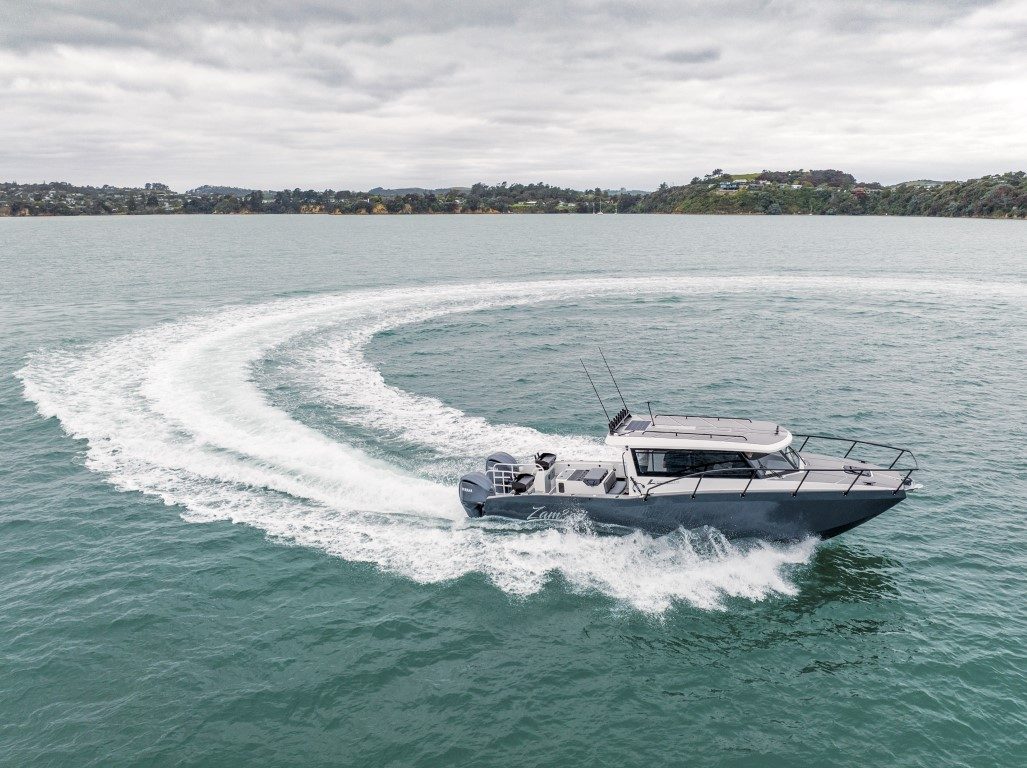
We maxed out at 43 knots, a stunning performance for a vessel of this size carrying three passengers and a half tank of fuel. Behrens says they switched to another prop combination a week after our test and achieved 46.5 knots with a similarly half-loaded vessel. With the new props and cruising at 32 knots the fuel consumption is 85 litres per hour (2.65 litres per nautical mile).
The impact of that dihedral foil begins as the speed climbs above about 27 knots – she becomes noticeably smoother at the higher speeds. This is a boat that benefits from more speed in rougher conditions, rather than by slowing down. We made turns at speeds above 30 knots, and although we all had to hold on, the ride was superbly controlled and comfortable.
Going through some swells was smooth and comfortable. The sharp edge of the asymmetric hulls easily cut through the water, and the wing deck is high enough to mitigate any slamming down off a wave.
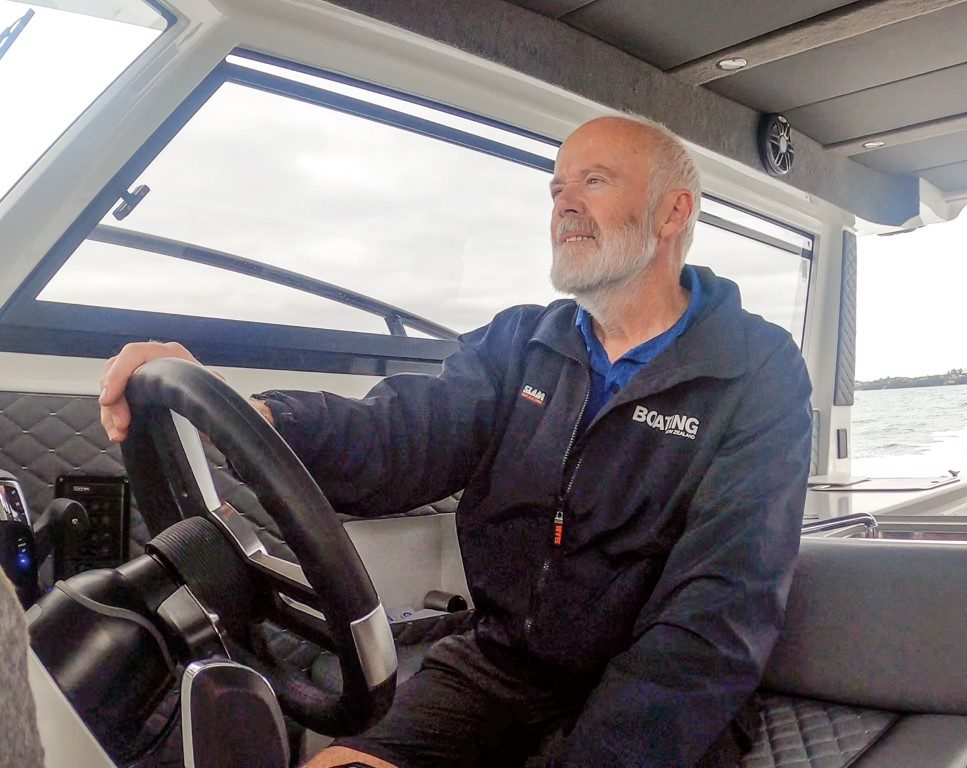
Coming down there was no checking motion from the foil, but equally when accelerating there was no explicit sensation of getting up on the plane – the hull remained almost perfectly horizontal and simply lifted smoothly up as she went faster.
Of course, the twin hull makes her very stable at rest, with no rolling or even any appreciable movement when we moved from one side to another. And backing up, important for game fishing, produced no dramas with the walk-through high enough off the water to prevent water ingress.
The Helm Master EX system controlling the motors has given me a serious case of steering envy – I want one for my own boat! It is very easy to use at speed, when mated with the autopilot, and when coming slowly into the marina.
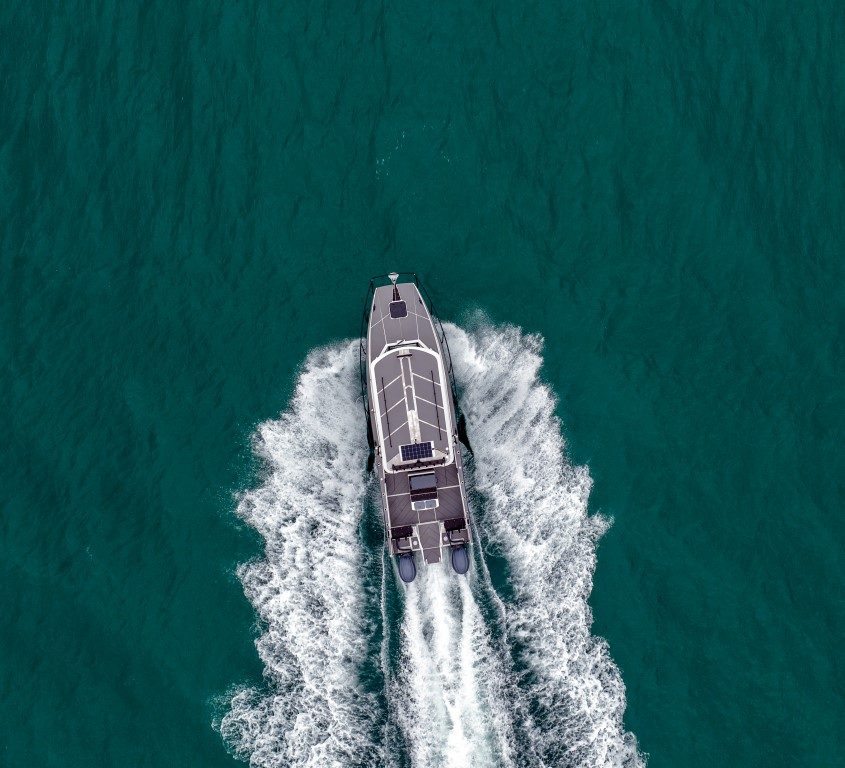
The joystick makes docking almost child’s play, eliminating any concerns with windage in a tight marina. And the touch-button autopilot function is perfect for long trips out when game fishing. Actually, anytime the skipper feels like taking it easy.
Overall, this is an impressive boat, perfectly suited in this configuration to serious fishing expeditions. With that top speed, the time spent getting there is minimised, while the autopilot makes the skipper’s job somewhat simpler.
The review boat was built to suit a specific purpose, but the same hull and cabin platform can easily be customised to be a more family-friendly overnighter. That superb handling means that even those with tender stomachs are likely to be untroubled, which makes a catamaran like this perfect for families.
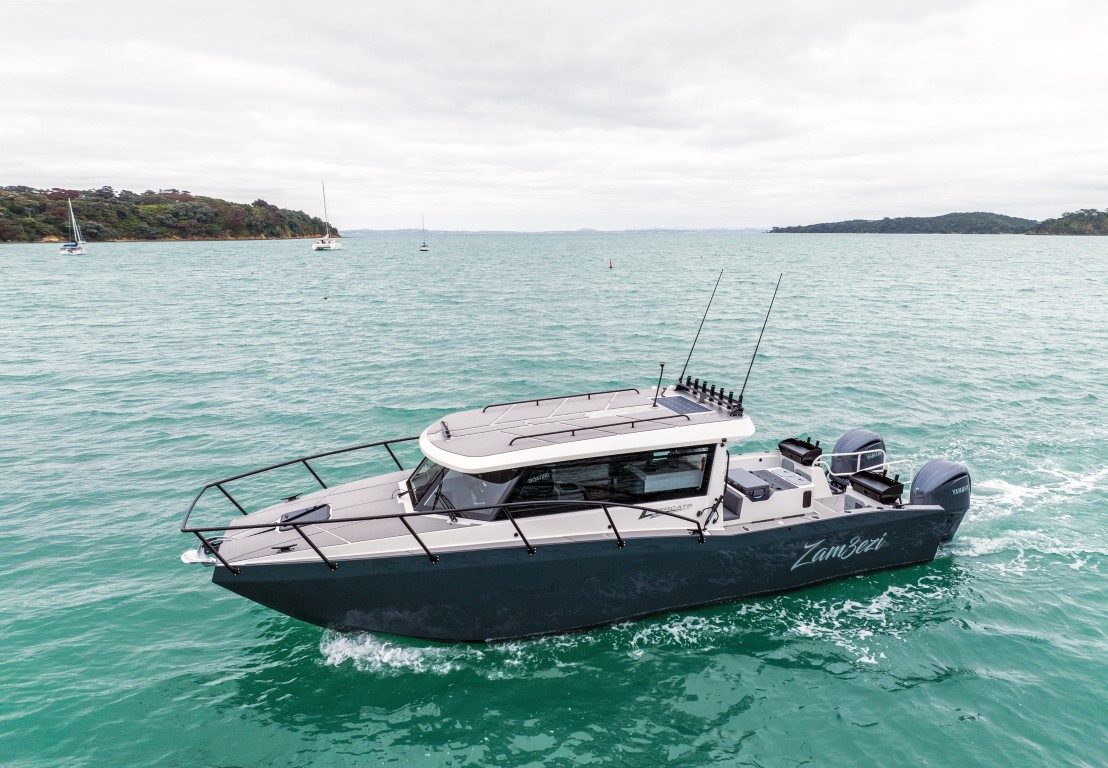
‘Behemoth’ is a word which springs to mind or, perhaps more nautically, ‘leviathan’.
White Pointer has earned the respect of discerning customers in New Zealand and Australia, attracting a loyal and ever growing following for its high-quality, rugged and totally dependable aluminium trailer boats.
The hardtop SP635 shares the same underpinnings as the popular SF 635 which was a completely new model back in 2020.
The pride and joy of a multi-generational family, Bliss resides on a pier that’s home to a couple of other Elite motor launches – Sandspit Marina is a hot-spot for the Bill Upfold-designed vessels, with several calling this small marina home.